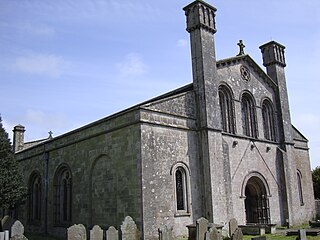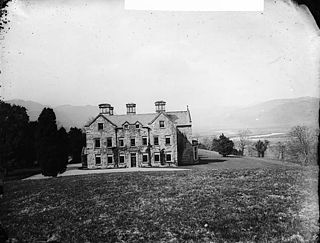
Hywel ap Cadell, commonly known as Hywel Dda, which translates to Howel the Good in English, was a Welsh king who ruled the southern Welsh kingdom of Deheubarth and eventually came to rule most of Wales. He became the sole king of Seisyllwg in 920 and shortly thereafter established Deheubarth, and proceeded to gain control over the entire country from Prestatyn to Pembroke. As a descendant of Rhodri Mawr through his father Cadell, Hywel was a member of the Dinefwr branch of the dynasty. He was recorded as King of the Britons in the Annales Cambriæ and the Annals of Ulster.

Deheubarth was a regional name for the realms of south Wales, particularly as opposed to Gwynedd. It is now used as a shorthand for the various realms united under the House of Dinefwr, but that Deheubarth itself was not considered a proper kingdom on the model of Gwynedd, Powys, or Dyfed is shown by its rendering in Latin as dextralis pars or as Britonnes dexterales and not as a named land. In the oldest British writers, Deheubarth was used for all of modern Wales to distinguish it from Hen Ogledd, the northern lands whence Cunedda originated.

The National Library of Wales, in Aberystwyth, is the national legal deposit library of Wales and is one of the Welsh Government sponsored bodies. It is the biggest library in Wales, holding over 6.5 million books and periodicals, and the largest collections of archives, portraits, maps, and photographic images in Wales. The Library is also home to the national collection of Welsh manuscripts, the National Screen and Sound Archive of Wales, and the most comprehensive collection of paintings and topographical prints in Wales. As the primary research library and archive in Wales and one of the largest research libraries in the United Kingdom, the National Library is a member of Research Libraries UK (RLUK) and the Consortium of European Research Libraries (CERL).

The White Book of Rhydderch is one of the most notable and celebrated surviving manuscripts in Welsh. Mostly written in southwest Wales in the middle of the 14th century it is the earliest collection of Welsh prose texts, though it also contains some examples of early Welsh poetry. It is now part of the collection of the National Library of Wales, having been preserved in the library at Hengwrt, near Dolgellau, Gwynedd, of the 17th century antiquary Robert Vaughan, who inherited it from the calligrapher John Jones and passed it to his descendants. The collection later passed to the newly established National Library of Wales as the Peniarth or Hengwrt-Peniarth Manuscripts.

The Black Book of Carmarthen is thought to be the earliest surviving manuscript written solely in Welsh. The book dates from the mid-13th century; its name comes from its association with the Priory of St. John the Evangelist and Teulyddog at Carmarthen, and is referred to as black due to the colour of its binding. It is currently part of the collection of the National Library of Wales, where it is catalogued as NLW Peniarth MS 1.

Cyfraith Hywel, also known as Welsh law, was the system of law practised in medieval Wales before its final conquest by England. Subsequently, the Welsh law's criminal codes were superseded by the Statute of Rhuddlan in AD 1284 and its civil codes by Henry VIII's series of Laws in Wales Acts between 1535 and 1542.

The Gospels of Máel Brigte is an illuminated Gospel Book, with glosses.

The White Book of Hergest was an important Welsh manuscript compiled in c. 1450. It contained many Welsh poems and prose texts and was a significant source for several antiquaries of the 17th and 18th centuries, but disappeared in the early 19th century, probably being destroyed in a fire in a London bookbinder's shop in around 1810.

The Peniarth Manuscripts, also known as the Hengwrt–Peniarth Manuscripts, are a collection of medieval Welsh manuscripts now held by the National Library of Wales in Aberystwyth. The collection was originally assembled by Robert Vaughan of Hengwrt, Merionethshire. During the 19th century it was held in Peniarth Mansion, Llanegryn.
Wales has produced a number of manuscripts over the centuries. Although most were written in Middle Welsh or Old Welsh, some were also written in Latin. In some of the more recent manuscripts it is not uncommon to have texts in Welsh, Latin, French and English in the same volume. However, some of the most important medieval manuscripts were written in Latin only, e.g. the Cyfraith Hywel.

NLW MS 20143A is a Welsh-language manuscript of the laws of Hywel Dda dating from the middle of the 14th century. It is one of the few surviving Welsh manuscripts of the period to have a medieval binding, and has been digitised by the National Library of Wales, which acquired the manuscript in 1969.
Peniarth Manuscript 259B, known as Pomffred since it had previously been owned by the constable of Pontefract Castle, is a version of the Laws of Hywel Dda. Aneurin Owen assigned this manuscript the siglum Z in his Ancient laws and institutes of Wales. It is one of the Peniarth Manuscripts in the National Library of Wales. It was transcribed in the mid-sixteenth century by two hands: Richard Longford and his amanuensis, from an earlier exemplar owned by Einion ab Addain, who was serving a prison sentence in Pontefract at the time that it was copied.
Peniarth Manuscript 32 is a fifteenth-century volume of the laws of Hywel Dda that contains a brief chronicle from Gwrtheyrn Gwrtheneu to King John, Paul's Vision, the Tree of the Cross, Brutus Saxonum, and various englynion. It is beautifully written on vellum in the hand of the scribe responsible for the Mabinogion in the Red Book of Hergest, and is bound in white vellum.
The Boston Manuscript of the Laws of Hywel Dda is a Welsh manuscript created in south-west Wales c.1350-1400 and added to by other scribes in the later Middle Ages. The complex composition of the manuscript has been mapped by archivists at the National library Wales. It is 99 vellum leaves and 98mm by 50mm and is not illuminated, although it does use some coloured inks. It was acquired at auction at Sotherby's by the National Library of Wales in 2012 for £541,250 and is now part of the General Manuscript Collection.
Daniel Huws FLSW is the world's leading authority of the last hundred years on Welsh manuscripts, with contributions that are held to represent a significant advance on those of John Gwenogvryn Evans.
Esboniadau ar Gyfraith Hywel Dda is a volume of commentaries on the Laws of Hywel Dda from the late fourteenth century that is known as 'siglum H'. The manuscript contains almost 500 triads and some unique material, but a large part of it is illegible because of the oak apples stains conferred on it by John Jones, Gellilyfdy.

The History of the Kings, or Brut y Brenhinedd, is a Welsh translation of Geoffrey of Monmouth’s Historia Regum Britanniae. The manuscript, which was copied in the late fifteenth century, is probably the only illustrated Welsh-language medieval narrative. It is part of the Peniarth Manuscripts collection at the National Library of Wales.

Hengwrt was a mansion near Dolgellau in Meirionnydd, Gwynedd. It lay in the parish of Llanelltyd near the confluence of the River Mawddach and River Wnion, near Cymer Abbey. With medieval origins, it was rebuilt or remodelled on several occasions before being demolished in 1962. It is remembered as the original home of the important collection of the Peniarth Manuscripts, now in the National Library of Wales.














